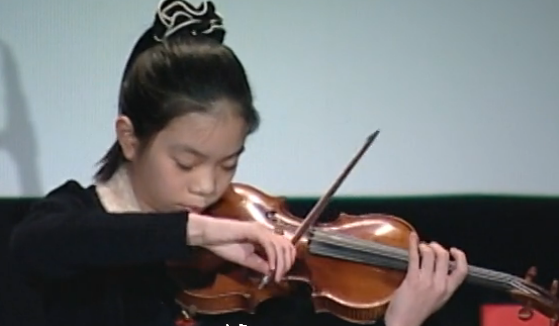Hi, everyone. I'm Sirena. I'm 11 years old and from Connecticut. Well, I'm not really sure why I'm here.
大家好,我叫黃凱珉。我今年十一歲,來自康涅狄格州。嗯,我確實不知道我為什么會在這里。
I mean, what does this have to do with technology, entertainment and design?
我的意思是,我和這些到底有什么關(guān)系,科技,娛樂和設(shè)計?
Well, I count my iPod, cellphone and computer as technology, but this has nothing to do with that.
好吧,我把我的iPod,手機和電腦都稱為科技,但這都和這個(小提琴)沒有關(guān)系。
So I did a little research on it. Well, this is what I found. Of course, I hope I can memorize it.
那么我做了一些研究。這是我的發(fā)現(xiàn)。當(dāng)然,我希望我能在這里記得說出來。

The violin is made of a wood box and four metal strings.
小提琴基本上是用木頭塊做的。
By pulling a string, it vibrates and produces a sound wave, which passes through a piece of wood called a bridge, and goes down to the wood box and gets amplified, but ... let me think.
它有四根主弦。通過拉弦,弦產(chǎn)生震動。結(jié)果產(chǎn)生一種聲波。聲音通過稱為琴馬的木板進(jìn)入木盒,然后得到放大??墒?,讓我想想。
On the other hand, placing your finger at different places on the fingerboard changes the string length, and that changes the frequency of the sound wave. (Sighs) Oh, my gosh!
想起來了,在另一方面,通過把手放在指板的不同位置,它改變弦的長度,這改變聲波的頻率。噢,我的天哪!
OK, this is sort of technology, but I can call it a 16th-century technology.
好吧,這就是所謂的科技。但我把它叫做十六世紀(jì)的科技。
But actually, the most fascinating thing that I found was that even the audio system or wave transmission nowadays are still based on the same principle of producing and projecting sound. Isn't that cool?
實際上,我發(fā)現(xiàn)最美妙的事是,當(dāng)時稱之為的聲音系統(tǒng),現(xiàn)在叫做聲波的傳遞,現(xiàn)在根本上還是基于同樣的原則,來產(chǎn)生和放大聲音。這是不是很酷?











